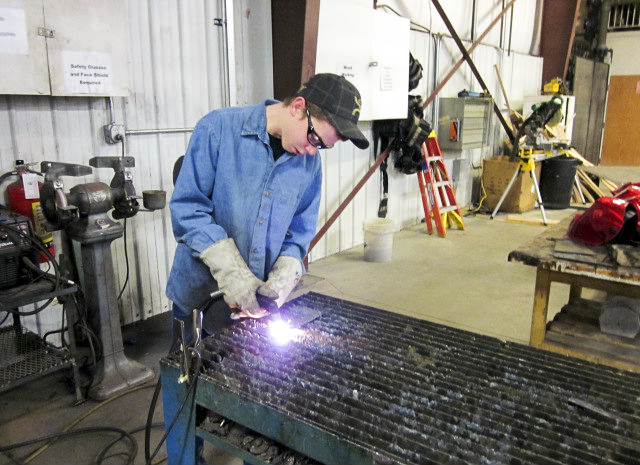
Many of the kids in this Soroco High School shop class aren’t in higher level math classes. But they're building something that requires the upper-level stuff: an octagonal round bale feeder.
Translation? An eight-sided steel structure, almost like a simplified jungle gym, that lets steer, horses and pigs stick their heads through the bars to eat hay. You see feeders all over the ranch landscape that surrounds this rural high school in Oak Creek, Colorado.
The structure is simple enough, but agriculture education teacher Jay Whaley says it can be complicated to build. So he went to the math teachers.
And teacher Maggie Bruski knew the round bale feeder would be a perfect way to reinforce Common Core math standards she teaches in her class.
Real world math is one of the driving principles behind those new, more rigorous standards that Colorado teachers are using in classrooms. Finding the real world connection can be tricky -- it wasn’t something math teachers always thought about when Bruski began teaching 13 years ago.
“Its way more rigorous now,” she says. “Students need to be able to make these leaps that they might not have been asked to make 10, 13 years ago and I think this project is a perfect example of one of those big leaps.”
First, getting the angles right
The Soroco High agriculture shop is massive, a warehouse full of old motorcycles, tractors, a greenhouse, and lots of machines. On the cement floor is the start of the feeder: a blue tape octagon, drawn with precise measurements, using the Pythagorean theorem.
The theorem helped them make accurate 90 degree angles. And the students all agree, getting those measures exactly right has been the hardest part of the project.
“Maybe somebody would not quite understand an equation right, sometimes you have to go back and redo some equations, redo some math, trying to make sure every angles right,” explained Bailey Singer. “Once you mess up the first time, you know what to do the second time you do it.”
Another Common Core goal is to have students actually debate over math solutions and process, which is exactly what happened in the hay bale project.
“We all worked together pretty well but on some occasions we would somewhat argue because one person would think something’s right and then one person would think it’s wrong,” said Harrison Ashley.
“Touching the math” important
“I think for our struggling students, projects like this one, where they’re able to sort out those difficulties and hopefully really see because they’re able to touch the math, not just try to do the math on paper,” Bruski said.
Bruski says the project though would have dovetailed perfectly with the math her upper level students were taking, the shop class of mostly freshmen just dove in and learned some trigonometry.
“The math we were doing to calculate all this was way more advanced than what we’re doing right now in class, so it was a whole new lesson we had to learn,” said Kendall Hood. “It’s different to see how the math you are doing in class, relates to real life. It definitely made it so there was a purpose in doing the math, not just to get numbers.”
Big machines
One part of the project that takes intense cooperation is when the kids operate the heavy-duty machines that will help them cut and weld pieces of steel together for the hay bale feeder.
“So there’s a lot of other science and applications they had to learn just to make the thing happen,” says agriculture teacher Whaley.
The kids learned tool use and safety procedures, MIG welding, arc welding, gas welding, and how to use the school’s new band saw.
When construction begins, Whaley reminds the students to be as accurate as they can:
“Two feet 10 and ¾ inches, that’s what you calculated, right? If you cut that the wrong way, you just wasted two feet of steel, right? And at $2.75 a foot.....”
They level the saw. It is difficult lining up the blade. There are a few stops and starts to get it just right. Then with a loud roar, the band saw cuts through the steel.
There are smiles all around when the end of their first piece of steel clanks on the ground.
“Looks pretty good,” says student Kendall Hood.
“You do need math”
It is projects like these, says Bailey Singer, that make her like math even more.
“I think math is one of the harder subjects for a lot of the kids. I think it’s harder to understand,” she said. “But once you see things like this, once you see how it comes into play with reality, it’s pretty amazing when you think all the different ways that you can use math, every day. Just building this it shows -- you do need math, you do need it.”
There’s still a lot of work to be done – welding the hay bale feeder together, priming it, and painting it.
“But hey,” said math teacher Maggie Bruski, “they’re going to have something that they built, and that they can sell to the community!”
The round hay bale feeder will go to the highest bidder at the Future Farmers of America year-end celebration.








